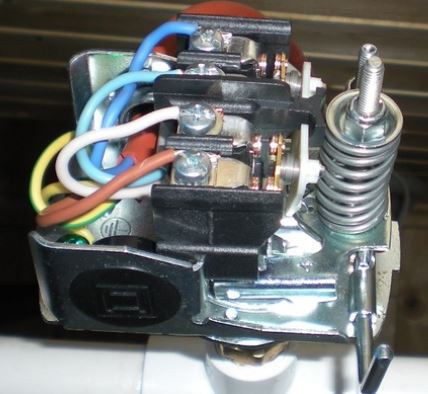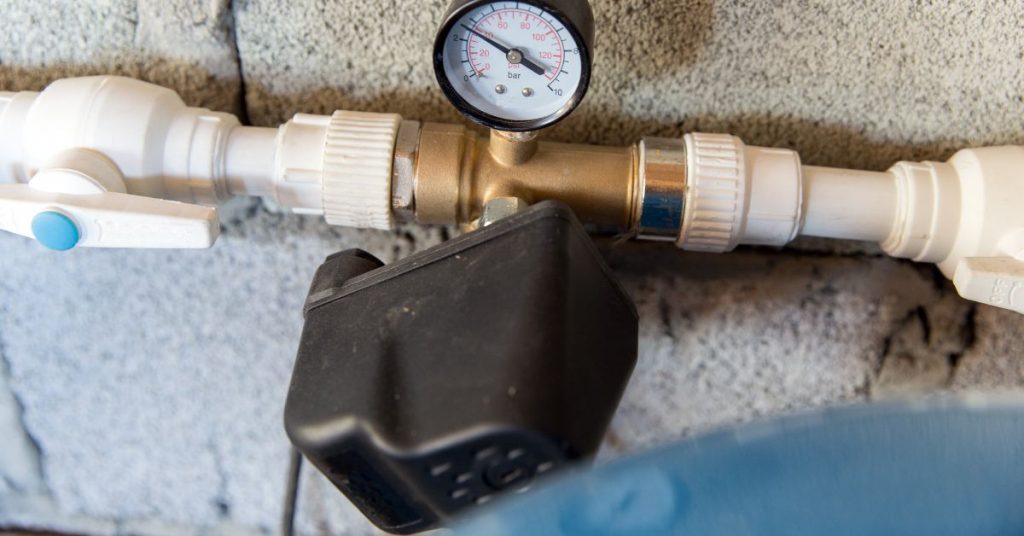
Replacing or installing a well pump pressure switch is a relatively straightforward process that helps regulate the water pressure in your well system. Here’s a summary of the key steps involved:
Safety Precautions
- Turn Off Power: Before starting any work, turn off the power to the well pump at the circuit breaker or disconnect switch to ensure safety.
Replacement/Installation Steps
- Drain Pressure: Open a faucet or valve in your home to relieve any pressure in the well system. This will prevent water from gushing out when you disconnect the pressure switch.
- Disconnect Electrical Wiring: Carefully disconnect the electrical wires from the existing pressure switch. These wires are typically connected to terminals on the switch.
- Remove Old Pressure Switch: Unscrew and remove the old pressure switch from the water pipe, typically located near the well tank or pump.
- Prepare New Pressure Switch: If you’re replacing the switch, ensure that the new pressure switch is compatible with your system and set to the desired pressure settings. You may need to adjust the pressure settings as needed.
- Install New Pressure Switch: Attach the new pressure switch to the water pipe in the same location where the old one was removed. Hand-tighten it, and then use a wrench to secure it snugly without over-tightening, which could damage the threads.
- Connect Electrical Wires: Reattach the electrical wires to the corresponding terminals on the new pressure switch. Ensure that the connections are secure.
- Test the System: Turn the power back on and open a faucet to test the well system. The pump should start, and water should flow. Monitor the system for any issues, and check for leaks around the new pressure switch.
- Adjust Pressure Settings (if needed): If the water pressure isn’t within the desired range, use a pressure gauge and adjust the pressure settings on the new switch accordingly. Refer to the manufacturer’s instructions for guidance.
- Secure Cover/Casing: If your pressure switch has a protective cover or casing, make sure it’s securely fastened to protect the switch and wiring.
- Monitor Performance: Keep an eye on the well system’s performance to ensure that it maintains proper water pressure and operates smoothly.
What to Know Upfront
As you already know, the pressure switch turns the pump on and off when the water pressure in the tank changes. Pressure switches therefore have 2 pressure settings, a lower one and a higher one.
The lower pressure setting when the pressure switch activates the pump is called the cut-in pressure. After sufficient water has filled the tank, the pressure switch turns the pump off at the cut-off pressure.
While buying a new pressure switch, you need to know its cut-in and cut off pressures. There are 3 main pressure switch settings. 20/40 psi, 30/50 psi and 40/60 psi. As you can see, there is usually a 20 psi difference between the cut-in and cut-off pressure.
Your old pressure switch’s cut-in and cut-off pressure will be written underneath its cover. If you were happy with your water pressure prior to the switch going bad, buy the exact same pressure switch.
If you weren’t, you can buy a pressure switch with a higher or lower pressure settings. Having said that, I should also add that a pressure switch’s cut-in and cut-off pressures can be adjusted as shown in this post.
That means if you have a pressure switch with a cut-in pressure of 30 psi and cut-off pressure of 50 psi, you can adjust it to have a cut-in pressure of 40 psi and a cut-off pressure of 60 psi. You can also adjust the pressure differential by either increasing or reducing the cut-off pressure.
Another thing to remember is that the pressure of the compressed air inside the pressure tank should be 2 psi lower than the pressure switch’s cut-in pressure. As you replace the pressure switch, you will need to check and adjust that pressure as well.
How to Replace a Well Pump Pressure Switch

For this project, you will need the following tools and equipment:
- New pressure switch
- Philips screwdriver
- Adjustable wrench
- Teflon tape
- Phone/camera
- Old toothbrush/wire brush
- Garden hose
- Multimeter/voltage tester
When you have gathered all the materials together, it is time to remove the old pressure switch and install a new one. The following are the steps to follow:
1. Turn off Power to Well Pump
While replacing the pressure switch, you will be handling naked wires which power up the switch. It is therefore paramount that the first thing you do is to turn off power to the well pump to prevent electrical shock.
Look for the breaker marked “Well Pump” on your main electrical panel and flip it to the off position. Better still unplug the pump’s power cord from the electrical outlet.
There is usually a plastic cover on top of the pressure switch connected using a small nut. Remove the cover and test if indeed power to the pressure switch has been cut off using the voltage tester/multimeter.
2. Disconnect Wires from the Pressure Switch
With the pressure switch cover out, you will see 4 electrical terminals, where there will be 4 wires tightened around screws. There will also be a ground connection at the bottom.
You will need a screwdriver to loosen the screws and pull out the wires. Before doing anything however, I would recommend that you grab your phone or a digital camera and a take a picture of the connections.
That will help you later in remembering exactly where each wire was connected. You can as well go an extra step and mark the wires with a pen before taking the picture.
After taking the picture, loosen the screws and pull out the wires. Do not forget the ground connection.
Note: It is very important to check how the wires enter the pressure switch opening. As you tighten the connections later, you want the screws to grab the wires tightly. More on that later in this post.
3. Drain the Pressure Tank
You cannot replace a pressure switch with well tank still full of water, unless you want to try and see what will happen.
Before disconnecting the pressure switch, you will first need to completely drain the tank. This will also give you the opportunity to check the pressure of the air chamber inside the tank and adjust it if needed.
- Turn off the shut off valve from pressure tank to your house plumbing.
- Connect a garden hose on the boiler drain at the bottom of the tank.
- Direct the other end of the garden hose out into the driveway, yard or floor drain.
- Turn on the drain valve and let the tank drain out completely. This will take a few minutes. Keep your eyes on the pressure tank. When the water pressure drops to 0 psi, the tank will have drained out completely.
If your installation looks a little different and you don’t have a boiler drain at the bottom of the tank, you will need to drain the pressure tank from the nearest faucet.
Note: Do not forget to turn off or bypass water filtration equipment to prevent them from being clogged up by sediment.
4. Remove the Pressure Switch
Use a wrench to grab the pressure switch locknut and loosen it by turning it counterclockwise. If the connection is really tight, I would suggest that you use a second wrench to back off on the pipe (nipple) where the pressure switch is threaded on.
This prevents the pipe from loosening instead of the pressure switch. You can also spray penetrating oil or lubricant like WD-40 on the connection and wait for about 15 minutes before attempting to loosen it again.
5. Install the New Pressure Switch
- Use a toothbrush or wire brush to clean up the threads on the pipe/nipple. This is important in removing old Teflon tape and mineral deposits.
- Apply about 6 wraps of Teflon tape on the threads. Teflon tape should be applied in a clockwise direction, since it is the same direction you will use to tighten the new pressure switch.
- Thread in the new pressure switch, starting off slowly to avoid cross threading. Tighten the connection with a wrench but not crazy tight.
- Connect the wires back as they were. Refer to the photo you took earlier and connect back the wires on the terminals. This time round you will need to start with ground connection since it is at the bottom.
- If the wires are a little rusty, clean them up with an emery cloth. This helps in creating a good contact.
Note: As I mentioned earlier, you will need to feed the wires in such a wire that they curl around the screw from the left (clockwise) and not the right side. By so doing, the wires will form good contact as you tighten the screws.
- Install the Pressure Switch cover
6. Check and Adjust Tank Pressure
As I had mentioned earlier, the pressure of the compressed air inside the pressure tank needs to be 2 psi lower that the pressure switch’s cut-in pressure (This is for bladder/diaphragm pressure tanks not air-over-water tanks).
You should always check the pressure when the tank is empty. Now that your tank is already drained, remove the cap on the air inlet valve at the top of the tank and connect a tire gauge. Check the pressure reading.
You can either bleed off pressure from the tank or add more using an air compressor or bicycle pump. 2-5 psi lower than the pressure switch’s cut-in pressure will be ideal.
7. Turn on the Pump
With the new pressure switch in place, turn on power to the pump. Make sure that the drain valve at the bottom of the tank is turned off.
Open the shut off valve to the house plumbing. To flush out air from the system, open a nearby faucet and only turn it off when it stops sputtering.
Do not forget to turn on the filtering equipment back on.
And basically that is how to replace a well pump pressure switch. If indeed you had a faulty switch the water pressure problem will have been resolved.
On the other hand if the problem persists, you may be having a faulty well pump. I have written a separate article about the signs that shows you need a new well pump. Read it here.





